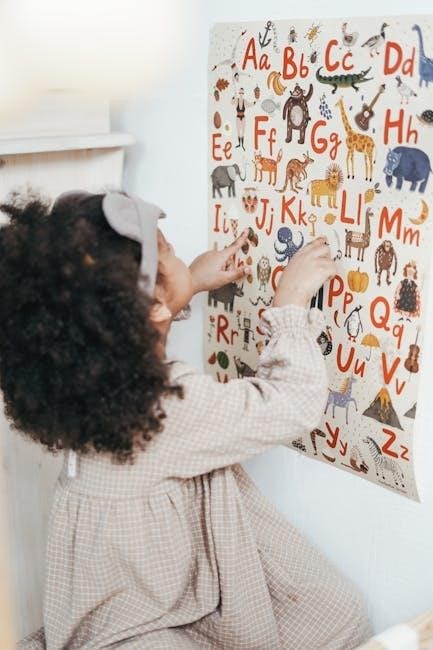Printable alphabet resources for kindergarten, such as posters, workbooks, and activity sheets, provide engaging tools for early learning. These materials, often in PDF format, are designed to help young children recognize letters, practice tracing, and develop essential motor skills. With colorful designs and interactive elements, they make learning the alphabet fun and accessible, laying a strong foundation for future reading and writing skills.
1.1 Overview of Alphabet Learning in Preschool
Learning the alphabet in preschool is a cornerstone of early literacy development. It introduces children to the basic building blocks of language, helping them recognize and remember letter shapes, sounds, and sequences. Printable resources like posters, workbooks, and activity sheets are essential tools for engaging young learners. These materials often feature colorful designs, fun themes, and interactive elements that make learning enjoyable. Activities such as tracing, matching, and coloring letters help children develop fine motor skills and hand-eye coordination while fostering letter recognition. By incorporating these resources, educators create a structured yet playful environment that encourages curiosity and lays the foundation for reading and writing skills.
1.2 Importance of Visual and Interactive Learning Tools
Visual and interactive learning tools are vital for engaging young children in alphabet learning. Resources like posters, flashcards, and activity sheets provide a hands-on approach, making lessons dynamic and enjoyable. These tools help children connect letter shapes with sounds, fostering recognition and memory retention. Interactive elements, such as tracing exercises and matching games, enhance fine motor skills and hand-eye coordination. By incorporating colorful designs and relatable themes, these materials capture children’s attention and make learning feel like play. This approach not only accelerates letter recognition but also builds confidence, encouraging children to explore and engage with the alphabet independently.
1.3 Benefits of Using PDF Formats for Educational Resources
PDF formats offer numerous advantages for educational resources, particularly for alphabet learning in kindergarten. They are easily accessible, requiring no special software beyond a PDF reader, making them universally compatible. PDFs maintain consistent formatting across devices, ensuring that visuals and layouts remain intact. They are also cost-effective and environmentally friendly, as they eliminate the need for physical materials. Additionally, PDFs can be scaled to different sizes without losing quality, making them versatile for various classroom activities. Their portability allows teachers to print multiple copies or share them digitally, ensuring that all students have access to the same resources. This format is ideal for creating durable, high-quality teaching aids that support interactive and engaging learning experiences.
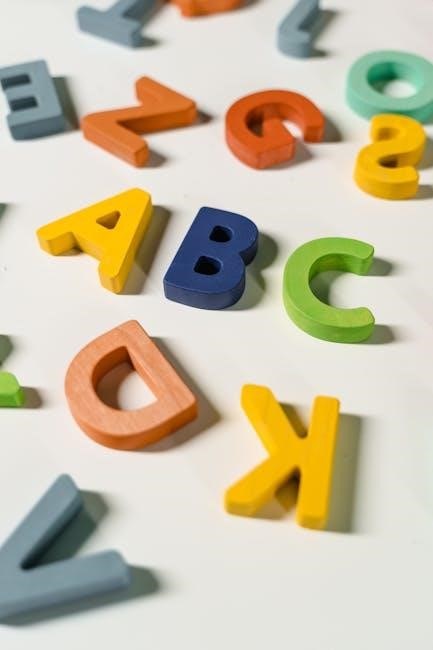
The Role of Alphabet Posters in Kindergarten Classes
Alphabet posters are essential visual aids in kindergarten, helping children memorize letter shapes and sounds. They decorate classrooms while providing constant reminders for letter recognition and learning.
2.1 How Posters Help in Recognizing Letter Shapes and Forms
Printable alphabet posters are invaluable for helping young children recognize letter shapes and forms. These visual aids feature large, clear letters, often paired with images or colors to enhance engagement. By displaying posters in the classroom, teachers provide constant visual reminders that help children memorize letter shapes. The consistent presentation of letters in posters aids in developing early literacy skills, as children can repeatedly observe and imitate the forms. Interactive activities, such as pointing to letters during songs or games, further reinforce recognition. Over time, this repeated exposure helps children build a strong foundation for reading and writing, making posters a cornerstone of alphabet learning in kindergarten.
2.2 Using Alphabet Posters as Classroom Decorations
Alphabet posters are not only educational tools but also vibrant classroom decorations that create a stimulating learning environment. By printing and displaying these posters, teachers can transform their classrooms into engaging spaces that inspire curiosity and learning. The colorful designs and clear lettering make them visually appealing, while their educational content reinforces alphabet awareness. Many posters feature thematic elements, such as animals or fruits, which add and relevance for young learners. Laminating or printing on high-quality paper ensures durability, allowing posters to remain a lasting part of the classroom decor. This dual purpose of decoration and education makes alphabet posters a practical and effective resource for kindergarten classrooms.
2.3 Interactive Activities with Alphabet Posters
Alphabet posters can be transformed into interactive learning tools through various activities, enhancing engagement and retention. Teachers can use the posters for scavenger hunts, where children identify and point to specific letters. Memory games, such as covering letters and asking students to recall them, also encourage active participation. Additionally, posters can serve as a basis for letter tracing exercises, allowing children to practice writing by tracing the letters on the poster. These activities not only make learning dynamic but also cater to different learning styles, ensuring that every child can benefit from the visual and tactile experiences provided by the posters.
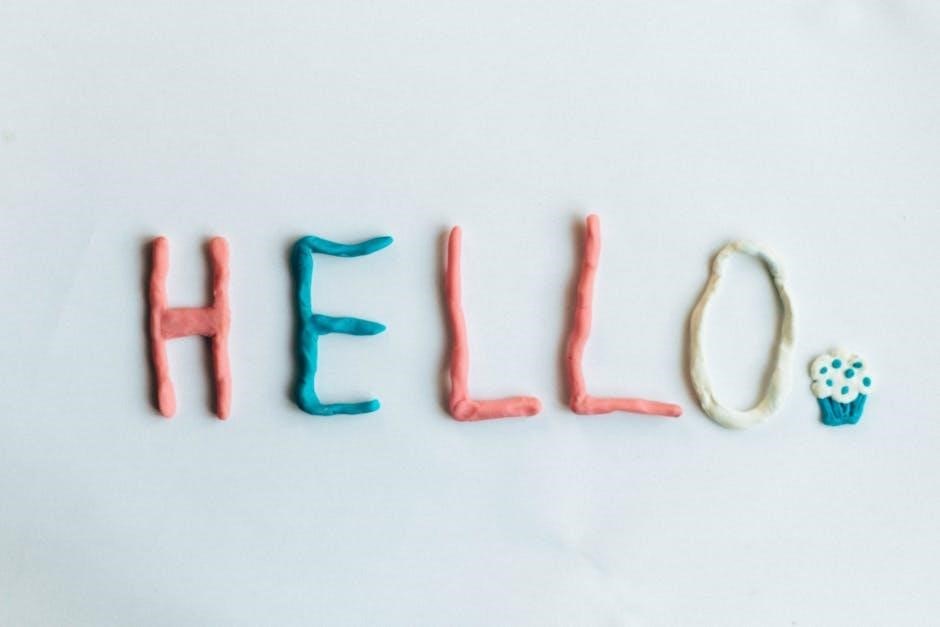
Printable Alphabet Workbooks for Tracing and Writing
Printable alphabet workbooks offer structured exercises for tracing and writing uppercase and lowercase letters. These PDF resources include step-by-step guides and fun designs to enhance motor skills and handwriting.
3.1 Features of Workbooks for Uppercase and Lowercase Letters
Printable alphabet workbooks for kindergarten include 26 pages, each dedicated to uppercase and lowercase letters. These PDF resources feature step-by-step guides for correct letter formation, making them ideal for tracing and writing practice. Designed for middle and upper kindergarten sections (MS and GS), they offer structured exercises to help children master both letter cases. The workbooks often include fun designs to keep young learners engaged. Teachers can print and distribute these materials easily, ensuring each child has their own copy for practice. Additionally, the workbooks can be divided into smaller booklets, allowing children to create their own alphabet book as they progress. These tools are essential for developing fine motor skills and handwriting abilities in a playful and organized manner.
3;2 Tracing Worksheets for Improving Motor Skills
Tracing worksheets are a key feature of printable alphabet resources for kindergarten, designed to enhance fine motor skills. These PDF exercises provide large, clear letter templates for children to trace, helping them develop hand-eye coordination and pencil control. The worksheets often include both uppercase and lowercase letters, allowing children to practice letter formation accurately. By repeating these tracing activities, young learners improve their ability to grip crayons or pencils correctly and move their hands in controlled motions. The repetitive nature of tracing also reinforces letter recognition and memorization, making it easier for children to transition to independent writing. These exercises are simple yet effective, catering to the developmental needs of preschoolers.
3.3 Step-by-Step Guides for Correct Letter Formation
Step-by-step guides for correct letter formation are essential tools in printable alphabet resources for kindergarten. These guides provide clear, visual instructions that help children learn the proper way to write each letter. By breaking down letter formation into simple, sequential steps, children can understand the correct starting points, direction of strokes, and how to connect lines. Many PDF resources include directional arrows and numbered instructions, making it easier for young learners to follow along. These guides also help teachers demonstrate letter writing in a consistent manner, ensuring that children develop good handwriting habits from the start. Regular practice with these guides reinforces muscle memory and improves accuracy in letter formation, preparing children for more complex writing tasks in the future.
Alphabet Activity Sheets for Engaging Young Learners
Alphabet activity sheets offer a variety of engaging exercises, such as matching games, coloring, and tracing, designed to captivate young learners and make learning fun and interactive.
4.1 Matching Games for Letter Recognition
Matching games are an excellent way to enhance letter recognition skills in young learners. These activities often involve pairing uppercase and lowercase letters or matching letters with corresponding images. Printable PDF resources provide colorful and engaging designs, making learning fun and interactive. For example, memory games where children match letters or letter-to-object pairs encourage visual recognition and memory development. These games are designed to be simple yet effective, helping children associate letters with sounds and objects. By incorporating these activities, educators create a playful learning environment that fosters early literacy skills and prepares children for reading and writing. They are ideal for kindergarten classrooms and home use.

4.2 Coloring Pages with Alphabet Themes
Coloring pages with alphabet themes are a delightful way to engage young learners while teaching them the alphabet. These printable resources, often in PDF format, combine colorful illustrations with letters, making learning fun and interactive. Themes like animals, fruits, and musical instruments captivate children’s attention, helping them associate letters with familiar objects. Coloring activities enhance fine motor skills, creativity, and concentration. They also provide an opportunity for children to practice letter recognition in a relaxed and enjoyable manner. Many PDFs offer intricate designs that make learning feel like play, ensuring that children remain motivated and eager to explore the alphabet. These pages are versatile and can be used in both classroom and home settings, promoting a love for learning from an early age;
4.3 Letter Tracing Exercises with Fun Designs
Letter tracing exercises with fun designs are an engaging way to help children practice writing letters. These printable PDF resources often feature themed designs, such as animals, vehicles, or musical instruments, to captivate young learners. Each worksheet typically includes uppercase and lowercase letters, guiding children to trace and replicate the shapes. Step-by-step arrows and dashed lines help children understand proper letter formation. These exercises improve fine motor skills, hand-eye coordination, and letter recognition. The fun designs make learning feel like play, keeping children motivated; Many PDFs also offer customizable options, allowing teachers to adapt activities to different learning levels. Such resources are versatile and effective for both classroom and home use, fostering a strong foundation in writing and literacy skills. They are ideal for early learners, combining education with entertainment in a creative way.

The Use of Cursive Writing in Kindergarten Education
Cursive writing in kindergarten introduces young children to flowing letterforms, enhancing fine motor skills and creativity. Printable PDF resources offer themed sheets, making early learning engaging and fun.
5.1 Introducing Cursive Letters to Young Children
Introducing cursive letters to young children in kindergarten can be a delightful experience with printable PDF resources. These materials often feature themed sheets, such as animals, fruits, or musical instruments, to capture their interest. Workbooks with 26 pages, one for each letter, provide a structured approach to learning cursive. Children can trace uppercase and lowercase letters in script, developing fine motor skills and hand-eye coordination. The colorful designs and engaging layouts make the process fun and interactive. Printable cursive alphabet sheets are ideal for preschoolers, offering a gentle introduction to the world of cursive writing while fostering creativity and a love for learning.
5.2 Benefits of Early Cursive Learning
Introducing cursive writing early in kindergarten offers numerous benefits for young learners. It enhances fine motor skills and hand-eye coordination through tracing activities. Cursive letters also improve letter recognition and formation, as they flow smoothly together. This early exposure fosters creativity and confidence in writing. Additionally, cursive learning strengthens cognitive development and memory, as children associate letters with movement and design. Printable PDF resources, such as themed sheets featuring animals or fruits, make the process engaging and fun. These tools help children develop a strong foundation for writing and prepare them for more complex literacy skills in the future.
5.3 Printable Cursive Alphabet Sheets
Printable cursive alphabet sheets are essential tools for teaching young children in kindergarten. These resources, often available in PDF format, feature uppercase and lowercase letters in script, with one letter per page for clarity. Themed sheets, such as those featuring animals, fruits, or musical instruments, make learning engaging and fun. They are designed to help children practice tracing and forming cursive letters accurately. These sheets are free, easy to print, and adaptable for various classroom activities. Teachers can use them to create interactive exercises or DIY workbooks, allowing children to progress at their own pace while developing essential writing skills in a creative and enjoyable way.
Interactive Alphabet Games for Kindergarten
Interactive alphabet games, such as letter matching Memory games and DIY scavenger hunts, engage young learners. These activities, available as printable PDFs, foster letter recognition and fun learning experiences tailored for kindergarten classrooms.
6.1 Letter Matching Memory Games
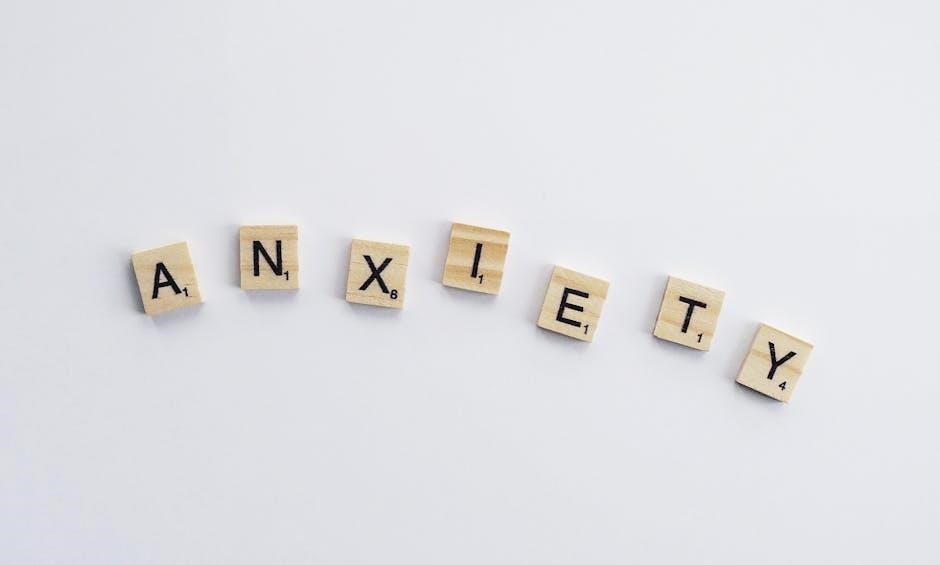
Letter matching memory games are an engaging way to help kindergarten students recognize and remember alphabet letters. These games, often available as printable PDFs, involve matching uppercase and lowercase letters, enhancing letter recognition and memory skills. Colorful illustrations and fun designs make learning interactive and enjoyable. Teachers can create pairs of letter cards for students to match, fostering concentration and cognitive development. Such activities not only make learning the alphabet exciting but also build a strong foundation for reading and writing skills. These games are ideal for young learners, encouraging teamwork and individual practice in a playful environment.
6.2 Alphabet Bingo and Card Games
Alphabet bingo and card games are effective tools for teaching kindergarten students letter recognition in a fun, interactive way. Printable PDF resources allow teachers to create bingo cards featuring uppercase and lowercase letters, along with corresponding pictures. These games encourage active participation, helping children associate letters with sounds and objects. Card games, such as matching pairs or memory games, also enhance cognitive skills and hand-eye coordination. The use of colorful illustrations and engaging designs makes learning the alphabet an enjoyable experience. These activities not only promote teamwork but also reinforce letter recognition, preparing young learners for reading and writing. They are versatile and adaptable to different classroom settings, making them a valuable addition to early education.
6.3 DIY Alphabet Scavenger Hunts
DIY alphabet scavenger hunts offer an engaging way to teach kindergarten students letter recognition while promoting active learning. Teachers can create scavenger hunts using printable PDF resources, such as alphabet cards or themed sheets featuring animals, fruits, or musical instruments. Children are tasked with finding and identifying letters in their environment or within prepared materials. This activity enhances letter recognition, memory, and problem-solving skills. Scavenger hunts also encourage teamwork and physical movement, making learning dynamic and fun. By incorporating visual and interactive elements, these hunts provide a comprehensive learning experience, helping young students build a strong foundation in alphabet knowledge and preparing them for reading and writing skills.
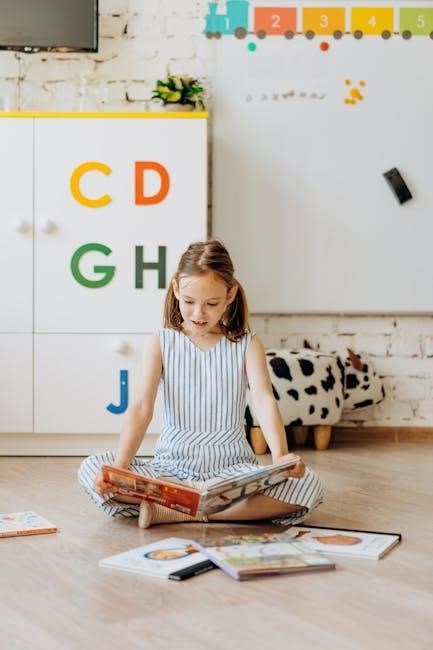
Benefits of Learning the Alphabet in Preschool
Learning the alphabet in preschool builds a strong foundation for reading, enhances memory and cognitive skills, and develops fine motor skills through activities like tracing and coloring.
7.1 Building a Strong Foundation for Reading
Learning the alphabet in preschool lays the groundwork for reading by introducing children to letter recognition, sounds, and their connections to words. Printable resources like posters and workbooks provide visual and interactive tools, helping children understand the relationship between letters and sounds. These materials often feature colorful designs and engaging activities, making learning enjoyable and effective. By familiarizing children with the alphabet, educators prepare them for decoding words and comprehension. Early exposure to letters also fosters phonemic awareness, a critical skill for reading development. Interactive PDF sheets and tracing exercises further reinforce this foundation, ensuring children enter elementary school with the skills needed to excel in reading.
7.2 Enhancing Cognitive and Memory Skills
Printable alphabet resources for kindergarten play a significant role in enhancing cognitive and memory skills. Activities such as tracing, matching, and coloring help children develop their ability to recognize and remember letters. Interactive PDFs and workbooks provide repetitive exercises that reinforce memory retention, while games like letter scavenger hunts encourage active learning. These tools also improve problem-solving abilities and hand-eye coordination, essential for overall cognitive development. By engaging with these materials, children build a strong mental foundation, which supports their ability to learn and retain new information. The combination of visual, tactile, and interactive elements makes learning the alphabet both effective and enjoyable for young minds.
7.3 Developing Fine Motor Skills Through Tracing
Tracing activities in printable alphabet resources are essential for developing fine motor skills in kindergarten children. By practicing letter tracing, children strengthen their hand muscles and improve dexterity, which are crucial for writing. PDF workbooks and activity sheets provide guided exercises, allowing children to replicate letter shapes accurately. These exercises also enhance hand-eye coordination and precision, laying the groundwork for fluent writing. Interactive tracing games and colorful designs make the process engaging, encouraging children to practice regularly. As they progress, their ability to form letters neatly and confidently improves, setting a solid foundation for future academic success.
Themed Alphabet Printables for Engaging Lessons
Themed alphabet printables, such as animals, fruits, and musical instruments, make learning engaging and fun for kindergarten students. These colorful designs capture young children’s interest while teaching letter recognition and formation, making lessons enjoyable and effective. They provide visual and interactive elements that cater to different learning styles, enhancing the overall educational experience.
8.1 Animal-Themed Alphabet Sheets
Animal-themed alphabet sheets are a popular choice for engaging young learners. Each letter is paired with a corresponding animal, creating a fun and memorable learning experience. These colorful sheets feature illustrations of animals like “A for Alligator” or “B for Bear,” helping children associate sounds with visuals. The combination of letters and animals captivates children’s interest, making alphabet learning enjoyable. Teachers can use these sheets as posters or activity handouts, encouraging children to trace letters and identify animals. They also include space for coloring, enhancing fine motor skills. Such themed resources make learning interactive and visually appealing, fostering a love for education from an early age while reinforcing letter recognition and formation skills effectively.
8.2 Fruit and Vegetable Alphabet Printables
Fruit and vegetable-themed alphabet printables offer a vibrant and engaging way for young learners to explore the alphabet. Each letter is paired with a corresponding fruit or vegetable, such as “A for Apple” or “B for Banana.” These colorful sheets are designed to capture children’s interest while teaching letter recognition and formation. They often include fun illustrations and space for tracing, making learning interactive. Additionally, these printables can be used for activities like coloring, which helps develop fine motor skills. By combining familiar food items with alphabet learning, these resources make education enjoyable and relatable, fostering a connection between letters and everyday objects while encouraging creativity and exploration in the classroom.
8.3 Alphabet Sheets Featuring Musical Instruments
Alphabet sheets featuring musical instruments combine learning with creativity, making the process engaging for young students. Each letter is paired with a musical instrument, such as “D for Drum” or “G for Guitar,” creating a fun and memorable connection. These sheets often include vibrant illustrations of instruments, making them visually appealing. They are designed to help children recognize and trace letters while introducing them to the world of music. Some sheets also include activities like matching games or instrument-related puzzles, enhancing cognitive skills and creativity. By integrating music with alphabet learning, these resources create a multisensory experience, fostering both educational growth and a love for the arts in kindergarten students.
Using Alphabet Flashcards in the Classroom
Alphabet flashcards are created from printable templates, offering versatile tools for recognizing letter shapes and sounds. They enhance interactive learning through various classroom activities and games.
9.1 Creating Flashcards from Printable Templates
Printable alphabet flashcards are easily created from PDF templates, offering a convenient way to teach letter recognition. Each card typically features a letter in uppercase and lowercase forms, along with corresponding images or themes, such as animals or musical instruments, to make learning engaging. Teachers can customize these templates to suit their classroom needs, printing them on cardstock for durability. Once printed, the cards can be laminated to extend their lifespan. This format allows for versatile use in various activities, making it an essential resource for interactive and visual learning in kindergarten classrooms. Flashcards are a practical tool for fostering letter recognition and memory skills in young children.
9.2 Games and Activities with Alphabet Flashcards
Alphabet flashcards offer a versatile tool for engaging kindergarten activities. One popular game is the memory matching game, where children pair uppercase and lowercase letters. Another activity involves using flashcards to play bingo, with pictures or objects corresponding to each letter. Teachers can also create scavenger hunts, hiding flashcards around the classroom for children to find and identify. Additionally, flashcards can be used for sorting games, grouping letters by shape or sound. These interactive activities not only enhance letter recognition but also promote teamwork and problem-solving skills. By incorporating movement and competition, flashcard games make learning the alphabet a fun and dynamic experience for young learners.
9.4 Tips for Effective Flashcard Use
For effective use of alphabet flashcards, ensure the letters are large and clear for visibility. Use images or objects alongside letters to aid recognition. Laminate cards for durability and reuse. Introduce a few letters at a time to avoid overwhelming children. Incorporate games and hands-on activities to keep sessions engaging. Consistency is key—practice regularly to reinforce learning. Encourage parental involvement by sending flashcards home. Track progress to identify letters that need more focus. Make it fun by incorporating rewards for correct answers. These strategies ensure flashcards remain a valuable, interactive tool for teaching the alphabet in a structured and enjoyable manner.
Printable alphabet resources are essential for kindergarten learning, offering interactive and visual tools that engage young children and lay a strong foundation for future academic success. Use them consistently to maximize educational benefits.

10.1 Summary of Key Points

Printable alphabet resources for kindergarten, such as posters, workbooks, and activity sheets, are essential tools for early learning. They help children recognize letter shapes, practice tracing, and develop motor skills. These materials, often in PDF format, are visually engaging and interactive, making learning fun. They provide a strong foundation for reading and writing skills. Resources like themed alphabet sheets and flashcards cater to different learning styles, ensuring variety and engagement. By using these tools, educators and parents can create a supportive learning environment, fostering a love for learning in young children. These resources are versatile, adaptable, and effective for kindergarten education.

10.2 Encouraging Continued Learning at Home
Parents and caregivers play a vital role in supporting their child’s alphabet learning journey. Printable PDF resources, such as alphabet workbooks and activity sheets, can be easily used at home. These tools allow children to practice tracing letters, recognize shapes, and engage in themed exercises, reinforcing classroom lessons. By incorporating these materials into daily routines, parents can create a nurturing environment that encourages continued learning. Simple activities, like tracing letters or matching games, can be done together, fostering a sense of accomplishment and curiosity. Consistent practice at home complements school efforts, ensuring a strong foundation for future academic success and a lifelong love of learning.
10.3 Final Thoughts on the Importance of Alphabet Resources
Printable alphabet resources are indispensable for early childhood education, offering a versatile and engaging way to introduce young learners to the foundations of literacy. These tools, such as posters, workbooks, and activity sheets, cater to different learning styles, ensuring that every child can benefit. By combining visual, tactile, and interactive elements, they foster cognitive development, fine motor skills, and a strong understanding of letterforms. Their accessibility in PDF format makes them convenient for both teachers and parents, providing endless opportunities to practice and reinforce alphabet knowledge. Ultimately, these resources play a crucial role in preparing children for reading and writing, laying the groundwork for lifelong learning and academic success.
